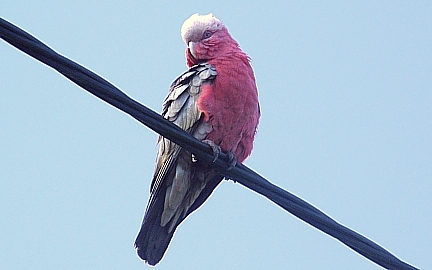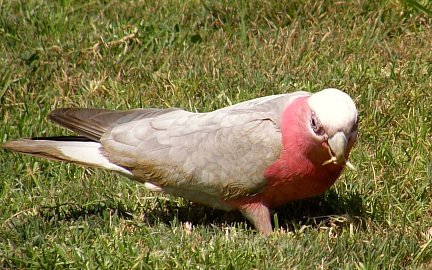
In a nest lined with gum leaves usually in a tree hollow, the female will lay between two and six eggs, with both the male and female taking turns to incubate the eggs over the next 30 days. The male galah makes himself heard during breeding season, chirping, and screeching to get the attention of its spouse. Preferring to stick with one mating partner for life, galahs are monogamous and will only re-couple if their partner dies but otherwise spend most of their time with their pair, feeding, cleaning, and playing. Flocks of between 500 and one thousand galahs are common. Enjoying a diet of seeds, as well as fruit, berries, roots, and grubs, these birds will feed mostly from the ground and then retreat into the protection and shade of the tree canopy during the hottest part of the day. When food is abundant, galahs can be found in huge quantities, with noisy flocks of between 500 and one thousand birds not uncommon. A common sight in most backyards, the galah inhabits most areas within the country including open woodlands, parks, roadsides, fields, and farmlands and has benefited from land clearing for stock that came with European settlement. Living in most parts of Australia, except in heavily dense rainforest areas, the galah can also be found in Tasmania and was thought to have migrated over the Bass Strait under its own wing. Providing water to birds is not just about helping them, I believe it can also bring enjoyment to us as we get to have experiences like this.Male galahs have brown eyes, while the females have red. I really enjoyed this brief encounter, as this magpie gained some relief from the heat while displaying trust in me. I suppose the Maggie eventually felt it was satisfied, as it flew to the top of a wood pile closer to me before departing to a tree. It did this several times and I gave that plant a good watering as I felt compelled to play my part by holding the water steady for this bird to enjoy. It would then walk away from the droplets to shake the water off, before returning. It stayed there for a while, getting low in the dirt while moving around. While I was watering a plant the magpie walked to the area just short of the plant where droplets were falling like rain. I thought it was going to to fly off when I saw it take to the wing but it flew to the other side of the garden where I was pointing the hose. I let the bird enjoy the water while I kept watering. The bird would wash, then get back onto the lip to shake itself, before repeating the process. It had a drink then walked into the bath to let the water wash over it.

As soon as I switched the hose off and turned away from beside the bird bath the maggie was straight up on to the lip of the bath. Every now and then bracing itself like it was about to jump onto the edge of the bird bath but being a little concerned, probably as I was still there making a noise with the hose. The magpie waited on a nearby rock while I filled the bird bath.

I took the hint and put some fresh, cool hose water in the bird bath. It kept walking past me to the place where I had just been watering so it could put its beak in a small pool of water that had formed near the plant.

It was a magpie walking along less than an arm’s length from me. While I was occupied with pointing the hose in the right direction I saw movement of a black and white object out of the bottom corner of my right eye. As an example, only a week or so before this day I was watering some of our plants in the back garden. I think one reason for their popularity is that magpies can become very accustomed to humans, even interacting with a familiar person. An Australian Magpie ( Cracticus tibicen) was the first bird I photographed that day, somewhat appropriately given how popular these birds are in Australia.


 0 kommentar(er)
0 kommentar(er)
